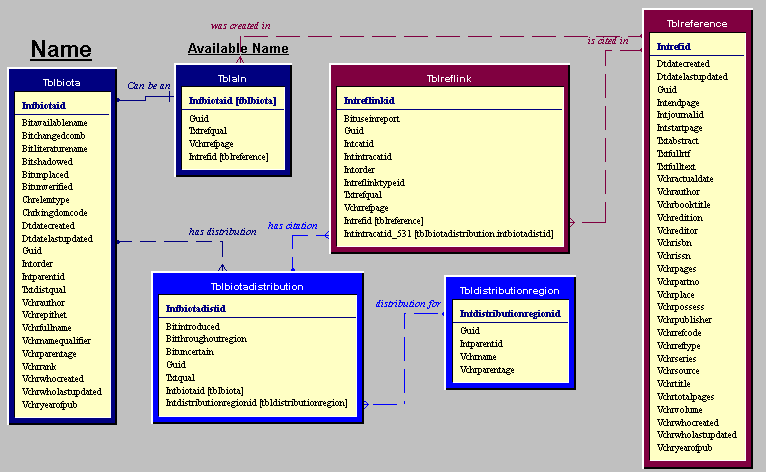
General: You can use the wildcards * (to match zero or more characters) or ? (matches exactly one character) in the taxon name and author searches. You may enter only a single search term per field (A taxon name search for "alba and albus" or "alba albus" will not return any results, as it will look for a name that matches the string "alba and albus"). Terms in separate fields are linked as an and search (Taxon name = "alba" and Author = "Deshayes"). Searches are not case sensitive.
Taxon Name: For a generic or trivial epithet, try just the epithet alone (e.g. alba), for a combination try the combination with wildcards (e.g. Mitromorpha * alba *)
Author: Try Placing wildcards before and after the author's last name. (e.g. *Adams*)
Year: Enter a year, no wildcards. Searches for a range of years have not been implemented yet.
The OBIS Indo-Pacific Mollusk database is stored in a BioLink database. We use both BioLink and a custom written Java application for data entry. This web database is served from a copy of the data from the relevant BioLink tables into tables in a mySQL database. In addition, some information has been stored by extending the BioLink keyword facility. This information includes the original literal form in which a name was published, and the original genus for species "available names" (sensu BioLink). The web search interface is intended to allow targeted searches for information in the database without the need for detailed knowledge of how information is stored in the tables.
A brief summary of the core tables and fields is below. A more detailed information model is available as a pdf .
Entity-Relationship diagram of core BioLink tables used by the Indo-Pacific Mollusk Project.

The following BioLink tables are currently present in the mySQL copy of the Indo-Pacific Mollusk database.
| tblBiota | Taxon Names (contains names in current use at all ranks, synonyms, and chresonyms) |
| tblSAN | Available Name information for species rank taxa |
| tblSANTypeData | Type Specimen information |
| tblSANTypeDataType | Type Specimen information |
| tblGAN | Available name information for genus rank taxa |
| tblGANIncludedSpecies | List of species included in genus |
| tblALN | Available Name information for higher taxa |
| tblBiotaDistribution | Geographic distributions of names in current use |
| tblDistributionRegion | Geographic regions defined in the Indo-Pacific |
| tblKeyword | Link between keyword names and other tables |
| tblKeywordType | Keyword Names |
| tblRefLink | Citations (link between References and other tables. |
| tblRefLinkType | Types of Reference Links |
| tblReference | References |
| tblJournal | Journal Names |
| Field | Type | Null | Key | Default | |
| intBiotaID | int(11) | Primary Key | 0 | ||
| intParentID | int(11) | MUL | 0 | ||
| vchrEpithet | varchar(32) | MUL | |||
| vchrFullname | varchar(100) | YES | MUL | NULL | |
| chrElemType | varchar(10) | YES | NULL | ||
| vchrParentage | varchar(255) | YES | NULL | ||
| bitAvailableName | int(11) | -1 | |||
| bitLiteratureName | int(11) | -1 | |||
| vchrYearOfPub | varchar(10) | YES | NULL | ||
| vchrAuthor | varchar(50) | YES | NULL | ||
| bitChangedComb | int(11) | YES | NULL | ||
| vchrWhoCreated | varchar(32) | YES | NULL | ||
| vchrWhoLastUpdated | varchar(32) | YES | NULL | ||
| txtDistQualifier | text | YES | NULL | ||
| dtDateCreated | date | YES | NULL | ||
| dtDateLastUpdated | date | YES | NULL | ||
| bitUnverified | int(11) | YES | -1 |
BioLink stores divides names into three categories 1) "Taxon Names", that is probably valid names in current use; 2) "Available Names", that is names that represent nomenclatural actions and might or might not be available names (sensu ICZN), these are names that would be entered into a synonymy; 3) "Literature names", that is names that do not represent nomenclatural actions such as changed combinations or non binomial names, these are names that might be included in a chresonomy. These three categories of names are identified in BioLink by two binary fields in tblBiota (bitAvailableName and bitLiteratureName). One of these two fields may take on a value of -1 (=true), indicating the name is of that sort, if both are 0 then the name is a "Taxon Name".